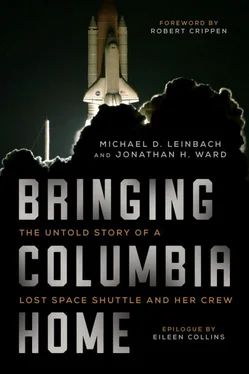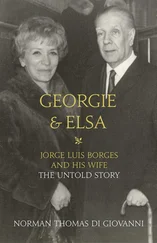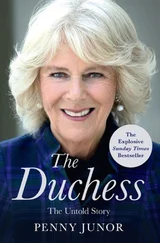The mystery of Columbia ’s demise had been conclusively solved.
The last truckload of debris arrived at the reconstruction hangar on May 6. Wreckage that had been strewn over thousands of square miles of forest and field—pieces that had been carefully collected by tens of thousands of searchers working in tough conditions for three months—was all here in this one place. The twisted, burned, and shattered debris had told an important story, one that would have been impossible to write without the collective efforts of so many dedicated people in East Texas and Louisiana and of the nation’s wildland firefighting teams.
In the end, Columbia ’s debris represented hope for the future of the program. “Each piece was evidence of how hard Columbia fought to come home to us,” Pam Melroy said. “We saw every recovered piece as a victory.” Every piece of debris moved the reconstruction team closer to their goal: We will find the problem, fix it, and move forward in their honor . [24] NASA reconstruction video.
However, this was not the end of the story of the reconstruction hangar and the debris. This was just another intermediate stop on Columbia ’s journey home.
PART IV

A BITTERSWEET VICTORY
We do not know where this journey will end, yet we know this: Human beings are headed into the cosmos.
—President George W. Bush, January 14, 2004
Chapter 12

HEALING AND CLOSURE
The long process of bringing closure to the story of Columbia began on February 11, 2003, when the final crew member was recovered in Sabine County. That same day, Ilan Ramon was buried at Moshav Nahalal in the Jezreel Valley in Israel. Rick Husband was buried in Amarillo, Texas, on February 21. A few days later, a memorial service was held for Kalpana Chawla at Zion National Monument in Utah, one of her favorite places. Willie McCool was buried in Anacortes, Washington, on March 4. Mike Anderson was buried on Friday, March 7, at Arlington National Cemetery. In a completely private gathering, President and Laura Bush spent nearly two hours with the families at the White House after Anderson’s service. After they spent an hour in conversation in the Oval Office, the president personally took them on an impromptu hour-long tour of the residence. [1] Sean O’Keefe email to Mike Leinbach and Jonathan Ward.
On what would have been her forty-second birthday, Laurel Clark was laid to rest at Arlington on March 10. Dave Brown was interred nearby on March 12. Clark, Anderson, and Brown’s graves are near the Columbia Memorial and within a short distance of where the Challenger astronauts are interred. Dave Brown’s brother Doug held a celebration of Dave’s life after his interment. The family and friends tried to keep the mood light—an occasion to swap funny stories about Dave and the impact he had on their lives.
During the celebration, Doug took Ann Micklos aside and said, “I’m not supposed to tell you this, but—they found your watch.” She was floored.
Because of the privacy surrounding the crew module reconstruction area, none of the workers in the rest of the hangar knew anything about the crew’s personal effects that had been recovered. As she talked to Doug, Micklos learned that many personal items had already been returned to each of the crew’s spouses. NASA told Doug about the watch. But because of Ann’s “unofficial” relationship with Dave, she was not considered a family member. Protocol prevented NASA from releasing information about the recovered watch or returning it to her.
Doug fully supported her getting the watch back, and he helped start the paperwork to have it released to her. At the end of April, he called her to say that he had the watch in hand. She asked him to overnight it to her.
As she opened the package and inspected its contents, the condition of the watch amazed her. The leather band had burned away during reentry, and the crystal had shattered. However, the face of the watch was intact. The hands had stopped at 9:06—either when the crew module broke up or when the watch impacted the ground. Momentarily putting aside the sobering thoughts about what the watch had been through, Micklos laughed to herself that Dave had been thoughtful enough to set the watch to Eastern Time for her.
Micklos took the watch back to the reconstruction hangar to show Pam Melroy’s team she had received it. They were ecstatic to finally be able to discuss it with her. The watch had been processed through the crew module room, where it was treated like every other item of crew personal effects. The team had known for weeks it was hers, but they observed protocol and did not say anything to her about it. With the veil of secrecy finally lifted, everyone could celebrate the watch’s recovery and return.
Melroy told Micklos several other watches had also been recovered. Micklos’s watch, however, was the only one with the time of the accident preserved on its face. The crew module team had even debated as to whether that time indication could be used as evidence in the investigation. However, they concluded that because the watch was considered personal property and not official flight hardware, it could not be used for evidence. [2] Interviews with Ann Micklos, Pam Melroy, and John Biegert. Biegert said that many of the digital timers used by the crew survived reentry and were recovered in working order, although their displays were fogged over.
The story of the watch has one final chapter. On February 1, 2004—the first anniversary of the accident—Micklos asked to go out to the Shuttle Landing Facility runway with a couple of her colleagues to reflect on the loss of Columbia . USA shuttle landing technician Billy McClure volunteered to drive them.
Micklos went out onto the runway and had a moment of peace despite the morning’s heavy rain. Once back in the van, she and the group exchanged stories about their experiences with Columbia. McClure said he was one of the first responders from KSC to collect debris in Texas. He recalled walking along, scanning the ground, when something shiny caught his eye. He bent down to look at it, and saw it was a rectangular watch.
Micklos asked, “Did it have a blue face?” He said it did. Micklos was stunned. Out of all the people who searched for debris from Columbia , what were the odds that she would be in a van on the anniversary of the accident with the man who had found her watch? The astonishing coincidence brought everyone in the van to tears.
—
During the course of the spring and summer, large and small acts helped the recovery and reconstruction teams begin their own healing process. For many people, the most difficult thing they faced turned out not to be the grueling days in East Texas or long days on the hangar floor. It would be much harder for them to cope with the challenges they faced in returning to “normal” life, when the enormity of events of the winter and spring began to sink in.
KSC’s staff had to keep their emotions in check during their assignments in the field in order to cope with the intensity of the work situation. Pat Adkins said, “I didn’t have time to dwell on the fate of the ship and crew. I just lost myself in the work at hand, and I consider that a weak balm for it all.”
“It was pretty traumatic,” said René Arriëns. “I couldn’t even describe it to my wife. Only the people who worked with you could have understood it. I know Jerry Ross did. I could see it in his eyes. I saw him once in the command post. I just looked at him, and I knew.”
Читать дальше












